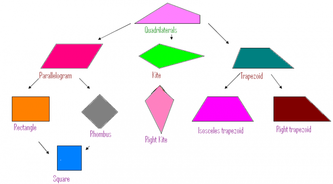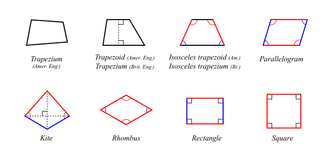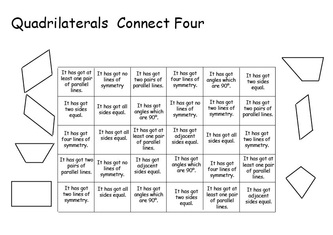For my weekly work, I researched ways to teach the concept of quadrilaterals and what characteristics make up the different types. I found examples of activities that I could do in a classroom where kids get to play quadrilateral games and they can learn from helping one another play. To start, I would first introduce the idea of quadrilaterals. If I was teaching a younger elementary class, I would begin by describing it's four sides and show pictures like the ones below. I would also try to explain the different types of quadrilaterals and let the kids each draw them so they can compare and talk together about what makes that shape.
To teach these shapes, I would describe what makes the shapes of quadrilaterals such as a square, rectangle, rhombus, parallelogram, trapezoid, kite, concave, and a general quadrilateral. I would make sure to show examples of what they look like and then have every student draw them on notecards so they can refer back if they forget what makes a shape. After they become familiar with the shapes I would introduce the concept of parallel and congruent sides. I would teach this in a way that would be interactive, rather than just talking, so I would create a game where the kids would have to sort quadrilaterals by being parallel or congruent.
I researched a few activities that would be fun in the classroom to review and help students learn from each other by talking and solving problems. I found a game called quadrilateral connect four. In the game, there is a paper game board with 30 squares, each containing characteristics of quadrilaterals. There is also game cards that have all of the quadrilaterals and the students would split up into two groups and work with their partner to place down cards that fit the description. The first teams to have four in a row would win the game.
Overall, in teaching quadrilaterals, I found that it is important to make sure students understand through hands on learning and working with other students. In classroom activities, it is important for kids to learn from one another because often students learn better when teaching others. From this lesson, I would be able to help students understand the different properties of shapes and build on the ideas for further lessons in math.
For my weekly work, I decided to research standard based grading in an elementary classroom, and found multiple examples of how to use them while grading projects and activities in math. I also found information on how teachers should ask questions in the classroom to engage students and make sure students understand the information that is meant to be learned. From my research, I discovered that standard grading and specific questions allow students to give forth better efforts when working because they have clear expectations.
From researching questions that teachers should ask in the classroom, I found that it is often difficult for teachers to check students understanding, especially of a math topic. It is easy to for the teacher to ask, "Does everyone understand?" when in reality not every student does. There are many ways that a creative teacher can solve this issue and one involves calling on students. If the teacher asks a question then waits about three seconds and calls on specific students, it allows every student to think of an answer along with ensuring that every student understands. Also another main way to check understanding is through standard grading.
To describe how standard based grading works, I researched an example of an elementary math rubric and found an activity to demonstrate how the assignment would be evaluated for understanding. For a math class students would be assigned a project where they would have to pick any object of their choosing and make a poster about it involving math and measurement. From this they would discover and understand how math is everywhere around them. To grade this, I would use a grading rubric that will be given to the kids before they have started their projects. I would grade on content (if they had eight or more math facts about their object,) pictures, attractiveness, grammar, and content accuracy. From this, students would know exactly what I expect from them to demonstrate an understanding of the math so they can give the effort that is needed.
Overall, I have discovered that using a standard grading rubric along forming effective ways to ask questions in a classroom, will be important when teaching to make sure my students are learning effectively. By using a rubric, students will know what is expected and can work according to what they need to make sure they understand. Also by effectively asking questions in class, I will be able to make sure that I am teaching in ways that my students can learn so they will be able to show understanding. This would allow students to learn from talking and listening to others which would be very useful especially in a math class.
For my third blog, I have worked on the idea of attribute blocks and how to relate the idea to patterns and hopefully teach this concept to elementary students. From the activity in class, "On The Bus," I understood how things can fit into certain categories based on their traits, such as characteristics of people or blocks. I found a few ways to expand the classroom activity of using Venn Diagrams by adding more circles and discovered that the objects or shapes have to have many characteristics for the game to work. I will be able to use attributes to teach about patterns by explaining that the patterns that make certain objects fit certain categories of the Venn Diagrams. I have found that those variables are the things that make up patterns.
The pictures above are examples of the blocks and Venn Diagrams that can be used for the attributes games. For the original game we used blocks similar to the ones above. The second picture is of a Venn Diagram that has four circles, which increase the number of spaces to 13 as shown. The third picture has five circles that increase the number of spaces to 31 showing that the items placed inside blocks for example would have to have a lot of variety and differences to be able to sort.
For an activity to teach this math concept, I would use a similar idea to the blocks except I would create a lesson with different things. I would tell my students to draw pictures of different animals and then would play a similar way by sorting and categorizing the animals. The students could make their own groups in the circles and let other students try to solve the patterns. In a classroom I could use this to let my students use hands on math that would hopefully allow them to visually understand patterns.
Overall I have learned that attributes in math are very useful for teaching students patterns. From this I have been able to come up with many of my own ideas of how to teach this to students and relate it to patterns. Originally I did not understand how the attributes block game or even the "On The Bus" game related but after solving the problems myself in class, I was able to see why and how to possibly teach this concept in math one day.
For my weekly work, I decided to focus on expansion patterns and the forms that they are made. I have created expansion patterns and found that they do not always turn out to look like the original figure whether it be a letter or a shape. I have also found a mathematical formula that can be used to predict the total number of squares at a certain size. From using this concept I will be able to use this as a lesson in a classroom in a way that would engage the students and allow them to visually see what they are learning. After working on expanding patterns I have seen how I can make this lesson very relevant to the students lives because patterns like this, are all around us.
The pictures above are some examples I found of expansion patterns. The first picture is of leaves that are gradually growing at the same rate each time. They grow similarly to how our math patterns grow. The second picture is of a plant stem which also grows at a steady rate. To begin my lesson with students, I would give practical examples like these pictures.
From the idea of expansion patterns, I created a couple patterns that I was able to discover a mathematical formula and issues that come with making them. For the first figure, I made the letter "r" which originally looked normal, but then as it expanded, it lost its from. For my second shape I made a cross shaped object that i was able to work through and create a formula.
5+4(S-1)= B. For the equation, I started with five because that is the base to start, and then added four because the shape grows by four blocks every time. Then I multiplied by "S" which is the size number and subtracted one. This equals "B" the number of blocks. This is an example of how to find the number of blocks for the 4th size:
5+4(S-1)=B
5+4(4-1)=B
5+12=B
17=B
In conclusion, from this idea of expansion patterns, I will be able to use this technique in a classroom. From my own experience with this topic I have learned the ways the patterns expand and ways that adding parts distorts some forms and can teach this to my students. I will be able to use the expansion in teaching from my own trial and error especially in formulas.













 RSS Feed
RSS Feed